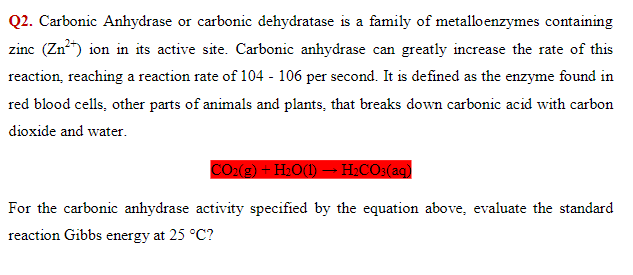Q2. Carbonic Anhydrase or carbonic dehydratase is a family of metalloenzymes containing zinc (Zn) ion in its active site. Carbonic anhydrase can greatly increase the rate of this reaction, reaching a reaction rate of 104 - 106 per second. It is defined as the enzyme found in red blood cells, other parts of animals and plants, that breaks down carbonic acid with carbon dioxide and water. CO:(2) – H20(1) – H;CO:(ag) For the carbonic anhydrase activity specified by the equation above, evaluate the standard reaction Gibbs energy at 25 °C?
Catalysis and Enzymatic Reactions
Catalysis is the kind of chemical reaction in which the rate (speed) of a reaction is enhanced by the catalyst which is not consumed during the process of reaction and afterward it is removed when the catalyst is not used to make up the impurity in the product. The enzymatic reaction is the reaction that is catalyzed via enzymes.
Lock And Key Model
The lock-and-key model is used to describe the catalytic enzyme activity, based on the interaction between enzyme and substrate. This model considers the lock as an enzyme and the key as a substrate to explain this model. The concept of how a unique distinct key only can have the access to open a particular lock resembles how the specific substrate can only fit into the particular active site of the enzyme. This is significant in understanding the intermolecular interaction between proteins and plays a vital role in drug interaction.

Step by step
Solved in 2 steps







